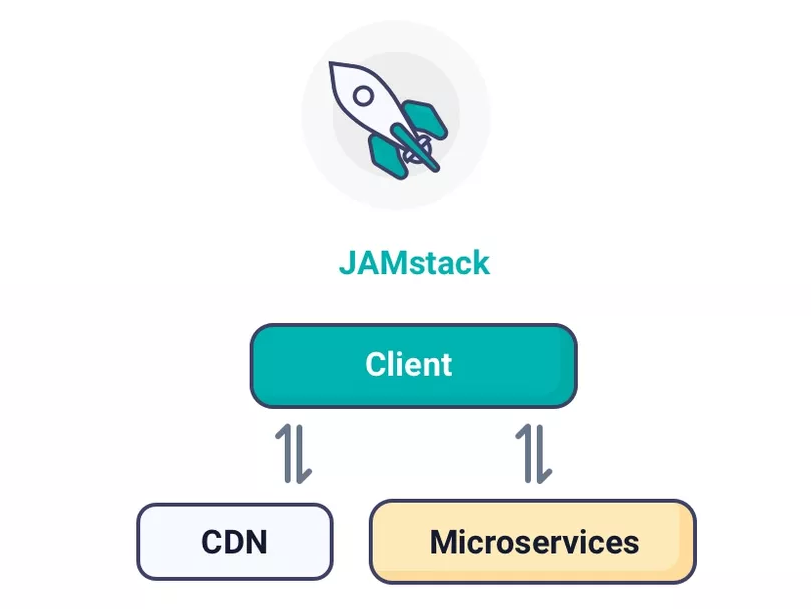We are always on the hunt for slick tools that help us simplify website development, improve site performance, lower costs and increase scalability. Jamstack is the whole package. Jamstack is a term initially coined by Netlify co-founder Mathias Biilmann and refers to a modern web development architecture based on three key components: JavaScript, API & Markup (JAM).
So, why all the hype about Jamstack? Read on as we explain:
- How Jamstack works
- Advantages of Jamstack
- Disadvantages of Jamstack
How Jamstack works
A lot goes on behind a website. And while Jamstack might be the way of the future, it’s still new enough that we wouldn’t recommend it for every site. When it comes to Jamstack’s role, we’re going to do our best to keep it simple. Traditionally, websites work like this:

Credit: Storyblok
As a user, your browser makes requests (asks for pages) of a web server that is connected to a database of content. You have a “conversation” with a web server each time you visit, and the server builds the pages as the conversation happens. While there are ways to optimize the process, generally this conversation is slower than it could be and requires storage and processing power on the part of the web server.
Jamstack is a new way to deliver websites to users. Users won’t be able to tell they’re on a Jamstack site—but they might feel the difference.

Credit: Storyblok
As a user, your browser makes requests of a Content Delivery Network (CDN), a geographically-distributed network of super-fast storage servers. The CDN “replies” faster than a traditional website because the replies (called Markup, the M in Jamstack) are mostly predetermined, requiring fewer resources.
In addition, your browser talks directly to other services to send and receive dynamic data and content. For example, an e-commerce site would talk to a payment processor; a real estate site might talk to a multiple listing service (MLS). These direct connections happen via JavaScript to Application Programming Interfaces (API) (the J and A in Jamstack).
(Side note: Sites that use traditional architecture can and do still use JavaScript and APIs. Jamstack sites just tend to rely on these more heavily. They also tend to execute these conversations via your browser rather than through a web server.)
What does Jamstack stand for again?
Javascript
Instead of web servers connecting to other services (e.g. an MLS), users' browsers tend to have these conversations directly through JavaScript.
APIs
Instead of storing all or most information in a database, information is sent to and from separate third-party services.
Markup
Instead of generating pages only when they are requested, pages are generated ahead of time and served from CDNs.
The Jamstack Pros
- It’s fast: Visitors don’t notice a site’s load speed until it’s slow and they’re frustrated. Jamstack loads fast because it relies less on a server and the database. Jamstack utilizes pre-built markup and assets over a CDN, increasing speed, web performance, and improving UX.
- It’s secure: Since Jamstack decouples (separates) the frontend from the backend, any security weaknesses found in the frontend code won’t infect the server. Plus, Jamstack doesn’t rely on databases and server-side applications, which are vulnerable to cyber attacks.
- It’s easy and cheap to scale: A CDN eliminates the need to manage server loads, supporting more scalability and flexibility than traditional web applications. What’s more, hosting static files is cheap, sometimes free. If your traffic skyrockets, a CDN requires fewer resources and doesn’t need a server upgrade, which means less expenses.
- It’s a developer’s dream experience: With Jamstack, developers are free from limitations or restrictions by certain platforms or technology. Jamstack gives developers the flexibility to choose their own tech stack, build with a wide variety of tools, and focus on the frontend experience. Additionally, as microservices and reusable APIs gain popularity, developers can reuse functionality across sites.
The Jamstack Cons
- It’s a more complex build: Jamstack sites require more complex build processes, which can significantly complicate site upgrades. As a result, the site can be more cumbersome to maintain. If you’re running a brochure site, Jamstack is probably not for you.
- It’s reliant on third parties: A Jamstack site relies heavily on third-party services, which means you need them to work all of the time, every time. If the third-party systems or APIs run into problems, your site may, too.
- It requires an expert: Setting up a Jamstack site requires a lot more technical know-how than a typical marketer or content editor likely has. What’s more, the global developer community isn't quite completely familiar with Jamstack yet. Choosing a Jamstack site means taking on a bit more risk – if you lose your developer, it may be harder to find someone new.
We stay on top of trends like Jamstack so you don’t have to. As your expert web partner, we make sure your website is always ahead of the curve.
